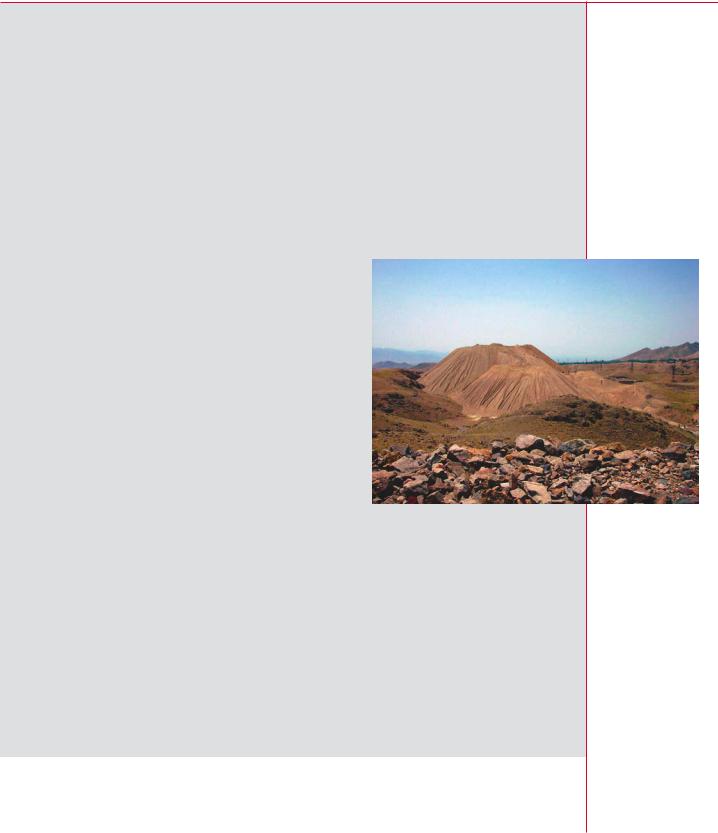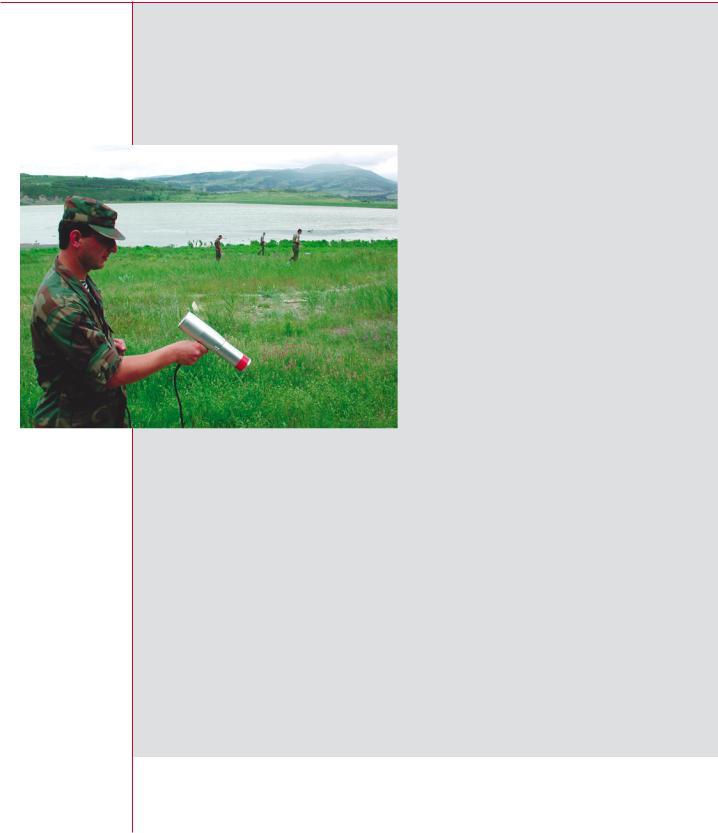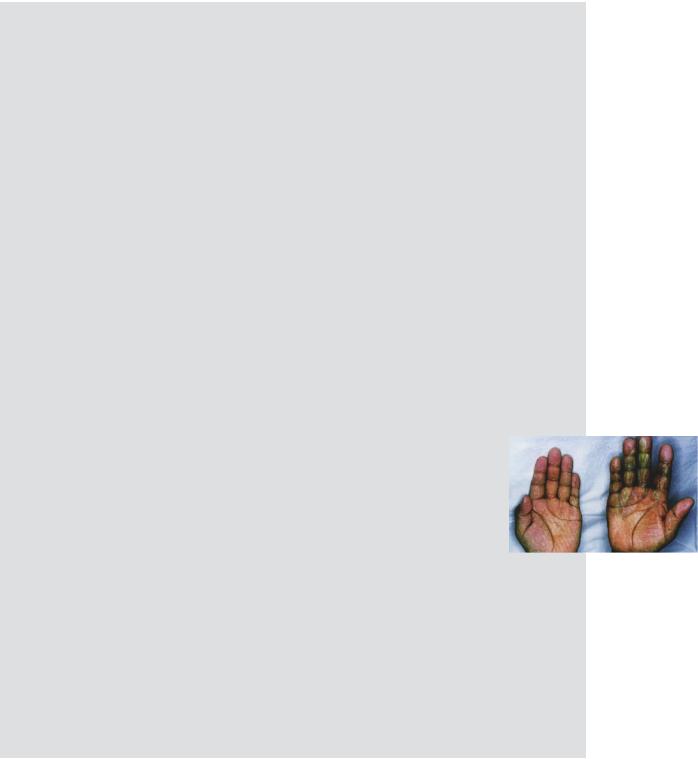
1radiation_people_and_the_environment
.pdf
Chapter 12 / Waste management
persist and that harm to future generations is of equal importance as harm to this generation. This response must of course be tempered by the uncertainties of making predictions of potential effects centuries and millennia from now.
Other waste management practices
Some other waste management practices in the past were, for various reasons, not as good as they should have been, and this has resulted in some cases of actual or potential long-term contamination of the environment.
Again, one example comes from military operations. Nuclear powered submarines from the northern fleet of the Soviet Union (and later the Russian Federation) have been taken out of service over the years. Many of these
submarines are currently in dock awaiting proper management, but in some earlier cases the Soviet Union put waste from submarine reactors, and even reactor fuel, into the sea, notably the Kara and Barents Seas in the Arctic. Between 1993 and 1997, The International Arctic Seas Assessment Project, co-ordinated by the IAEA, reviewed the situation and concluded that, because of the slow release of radioactivity from the solid wastes and the dilution provided by the sea, the doses to members of the public would be very low (less than 0.001 mSv per year). Military personnel stationed in the area could get significantly higher doses, similar to the doses already received from natural sources (up to a few mSv per year).
Several areas around the world are affected by large deposits of waste from the mining and processing of radioactive ores. This is most commonly from uranium mining, but in some areas the abundance of naturally occurring radionuclides is such that spoil from other types of mining (some of it as early as the Middle Ages) is also a significant radiological hazard. A number of industries, such as the manufacture of fertilizers and the oil and gas industries, also produce wastes of a similar nature. The radionuclides involved are all of natural origin, and hence it is only comparatively recently that these wastes have been recognized as a radiological problem. The levels of radionuclides in the ores were typically higher than average and have often been increased by chemical or physical processes, so they are significantly higher than usually found in nature (though their activity concentrations are not very high compared with those of nuclear waste). Furthermore, the radionuclides have extremely long half-lives, and there are often extremely large amounts of waste.
RADIATION, PEOPLE AND THE ENVIRONMENT
Unrehabilitated uranium tailings in Tajikistan
F. Harris/IAEA
57

Chapter 12 / Waste management
These wastes can be managed safely, for example in engineered, clay-capped impoundments, and countries such as Canada, the USA, Germany, and Australia have adopted such methods. However, some developing countries, e.g. central African countries and some of the central Asian republics that were formerly part of the Soviet Union, do not have the resources to handle such huge amounts of material in this way. The IAEA, among others, is helping these countries to find safe solutions.
58 RADIATION, PEOPLE AND THE ENVIRONMENT

Chapter 13 /Emergencies
Chapter 13 Emergencies |
|
Despite all the safety measures applied in using radiation and radioactive materials, |
|
accidents can happen. |
|
An emergency may arise at a nuclear installation and lead to the accidental release |
|
of radioactive material, its dispersion beyond the boundary of the site, and the need |
|
for urgent measures to protect the public. In some circumstances, the release may be |
|
brief, in others prolonged. Significant accidents have happened in 1957 at Windscale |
|
(in the UK) and at Kyshtym (then USSR, now Russian Federation), in 1979 at Three |
|
Mile Island (USA) and in 1986 at Chernobyl (then USSR, now Ukraine). Although such |
Demolition and |
accidents may be rare, it is prudent to be prepared for them. |
removal of rubble |
|
from a house |
Much more common are emergencies involving radiation sources from medical, |
contaminated |
industrial, research, and military applications. Over recent years, the IAEA has |
during the Goiânia |
received an average of three or four reports each year of emergencies where people |
accident |
have been exposed to high doses because such sources have been |
|
lost, stolen, abandoned, or operated wrongly. Since the 1987 accident |
|
at Goiânia, Brazil, in which four people died from exposure due to a |
|
medical radiation source found in an abandoned building, there have |
|
been more than a dozen fatal accidents worldwide involving radiation |
|
sources. (see Table on page 66) |
|
The Tokaimura accident in 1999 was unusual in that it involved a sus- |
|
tained nuclear reaction, started inadvertently in chemical processing of |
|
enriched uranium . The only release of radioactive material was a very |
|
small amount of very short-lived radionuclides. The radiological hazard in this accident |
|
was the direct radiation — especially the neutron radiation — coming from the vessel |
|
in which the reaction was taking place. Because it was not foreseen that such a reac- |
|
tion could happen, the building did not have the protective shielding that would have |
|
been present in a nuclear power plant, and so the radiation caused significant doses |
|
outside the building. |
|
Because some types of emergency can have consequences outside the country where the accident occurs, there are legally binding international agreements relating to emergencies. All of the countries with operating nuclear power plants (and more than 50 others) are parties to the Convention on Early Notification of a Nuclear Accident, which requires them to notify nearby countries if they have an accident that might affect those countries. They must also notify the IAEA, who will then help to disseminate
RADIATION, PEOPLE AND THE ENVIRONMENT 59

Chapter 13 /Emergencies
information about the situation. Over 80 countries are also party to the Convention on Assistance in the Case of a Nuclear Accident or Radiological Emergency, whereby they undertake to provide assistance in such an emergency if any country requests it. Again, the IAEA has an important role defined by the Convention, to disseminate information and co-ordinate assistance.
Nuclear emergencies
To ensure that there is adequate protection against accidents, national nuclear licensing authorities require detailed safety analyses of major nuclear installations such as reactors. These analyses identify potential accident sequences that might lead to the release of radionuclides. Emergency plans are based on consideration of the sequence leading to the largest release that can reasonably be foreseen, but they could be strengthened and extended in the unlikely event of a more severe accident.
Should an accident occur at a reactor, for example, various radionuclides in gaseous, volatile, or particulate form could be expelled to the atmosphere. They would then be carried away in a radioactive plume by the wind and be dispersed and diluted. Some would fall to the ground, particularly if it were raining. The concentration of radionuclides in the air would decrease rapidly downwind from the site, as would the
Depiction of resulting hazard. Even so, appreciable quantities of radionuclides could be deposited plume dispersion on the ground at considerable distances.
and deposition
Radioactive material carried by wind
Direct radiation
Inhalation
Rain washing material out of plume
Contamination
of food
Direct radiation from contamination
60 RADIATION, PEOPLE AND THE ENVIRONMENT

Chapter 13 /Emergencies
Countermeasures
It may be necessary to take action to reduce the radiation dose to the people living near to an accident site. Various countermeasures could be undertaken singly or in combination. Some of these measures — urgent countermeasures — really need to be initiated before there is a release of radioactive material, if they are to be effective. This means that decisions must be taken on the basis of what is happening at the plant (and what is predicted to happen), rather than waiting until a release is detected. This could sometimes mean that countermeasures are taken as a precaution that might turn out to have been unnecessary, but this is preferable to acting too late.
People may be advised to stay indoors or even leave home until the plume has blown over or the release has been stopped. People could take non-radioactive iodine tablets to prevent radioactive iodine reaching the thyroid gland. It may also be necessary to introduce temporary restrictions on the distribution of milk and vegetables and other foods produced locally. Some simple countermeasures might be taken after the plume has passed, such as hosing roads and paths or cutting and removing grass from gardens so as to remove surface activity.
When the emergency has passed, it may be necessary to introduce other countermeasures during a prolonged recovery period so as to protect the public from the residual activity.
There are elaborate and well-rehearsed plans for dealing with nuclear emergencies in countries with nuclear installations and also in many other countries that might be affected by an accident in a neighbouring country. Every nuclear site should have an emergency plan and let the local people know about it. The plan will involve the operator’s staff, the local governmental authorities and the emergency services. National government departments and agencies will also become involved: each will deploy its radiological resources and expertise.
A typical emergency plan would envisage the following sequence of events. In the early stages of an accident, the operator will advise the police on measures to protect the public. Soon a co-ordinating centre away from the site will be set up at which those people with defined responsibilities and technical advisors will decide upon actions to protect the public. These will include environmental monitoring, as well as appropriate countermeasures. Arrangements will be made to brief the news media.
As noted above, because nuclear accidents can affect large areas, the Convention on Early Notification of a Nuclear Accident also requires any country having an accident that could affect its neighbours to notify the IAEA and any countries that could be affected.
The need for emergency planning is not restricted to nuclear installations. Wherever radiation sources are used there should be appropriate contingency plans to cope with the types of emergency that could happen. These need not be on the scale required for a nuclear power plant, but they should address any accidents that could conceivably occur.
Countermeasures in an emergency
Sheltering indoors from the plume
Temporary evacuation of homes
Administration of iodine tablets
Ban on contaminated foodstuffs
RADIATION, PEOPLE AND THE ENVIRONMENT 61

Chapter 13 /Emergencies
International intervention levels for countermeasures
Action levels for some foods and for water (Bq/kg)
Source: The International Basic Safety Standards for Protection against Ionizing Radiation and for the Safety of
Radiation Sources, Schedule V, Table V-I
62
Intervention standards
Taking countermeasures after accidents is another example of the procedure that ICRP calls intervention. We have seen in Chapter 5 that intervention must be justified and optimized. It is only necessary to add that countermeasures must be taken to avoid doses high enough to cause obvious injury in anyone exposed — but especially children.
The BSS specify intervention levels of dose for the introduction of countermeasures to protect the public. These are used to identify which actions would be most suitable in particular circumstances.
Countermeasure |
Organ |
Dose level |
|
to be averted |
|||
|
|
||
|
|
|
|
Sheltering |
Whole body (effective) |
10 mSv in 2 days |
|
Evacuation |
Whole body (effective) |
50 mSv in 1 week |
|
Iodine administration |
Thyroid |
100 mGy |
|
|
|
|
|
|
|
|
Important |
Milk, infant foods and |
Other foods |
|
drinking water |
|||
radionuclides |
(Bq/kg) |
||
(Bq/kg) |
|||
|
|
||
|
|
|
|
Strontium-90 |
|
100 |
|
Iodine-131 |
100 |
|
|
Plutonium-239 |
1 |
10 |
|
Caesium-137 |
1000 |
1000 |
|
|
|
|
One outcome of the Chernobyl accident was the introduction of action levels for radioactive contamination of food by the Codex Alimentarius Commission of the FAO and WHO. These action levels, set out for the first year following an accident, are for international trade purposes, but also provide useful guidance to national authorities on local consumption of food products.
RADIATION, PEOPLE AND THE ENVIRONMENT

Chapter 13 /Emergencies
Public information
In most cases, when something goes wrong at a nuclear installation, the various levels of safety systems ensure that the situation is controlled and does not develop into such
an accident. It is only in very unlikely circumstances, where several safety systems fail, that an accident (event) may result. To provide the media and the public with a simple indication of how seri-
ous an event is, the IAEA and OECD/NEA have developed the International Nuclear Event Scale (INES). Events are rated on a scale of zero to seven: a rating of zero means that there was a problem
but that the safety systems worked properly and corrected it before there was any risk to workers or the public, whereas a rating of seven means a major nuclear disaster on the scale of the 1986 Chernobyl accident.
Other radiological emergencies
As with nuclear accidents, there are two sides to dealing with the risk of emergencies involving radioactive sources: doing as much as possible to prevent accidents, but also being prepared to respond should an accident happen.
Accidents involving radioactive sources can be prevented by ensuring that only those who are properly qualified and trained use and look after the sources. Established procedures should be followed to make sure that the source is used correctly and is not lost, damaged or stolen, or otherwise allowed out of the responsible user’s control. This requires that national authorities have a proper and reliable system in place to keep track of where sources are and who is responsible for them. Over the past few years, the IAEA, through its technical co-operation programme, has made significant efforts to help countries develop such systems for controlling the sources under their jurisdiction. Despite some progress accidents continue to occur, indicating that there is still work to be done.
RADIATION, PEOPLE AND THE ENVIRONMENT
The International
Nuclear Event
Scale (INES)
For prompt communication of safety significance
63

Chapter 13 /Emergencies
The IAEA is When accidents do occur, measures may be needed to recover control of the source helping Georgia involved and make it safe, to treat people who have been exposed as a result of search for the accident, and to investigate how the accident happened and hence learn how radioactive accidents can be avoided in the future. In many recent cases of this type, the sources countries concerned have requested assistance from the IAEA under the Convention abandoned in on Assistance in the Case of a Nuclear Accident or Radiological Emergency to carry
remote areas out one or more of these measures.
P. Pavlicek/IAEA
64 RADIATION, PEOPLE AND THE ENVIRONMENT

Chapter 14 / Risks from radiation sources
Chapter 14 Risks from radiation sources |
|
In normal everyday use, radiation sources and technologies are used by professionals |
|
in well managed, properly regulated institutions. As described previously, radiation |
|
sources can be generating devices, such as X ray machines or particle accelerators |
|
used in medicine. The sources can also be radioactive materials sealed in a secure |
|
capsule or housing. Some sources, particularly those used in nuclear medicine and |
|
research are radioactive materials in an unsealed form. Problems can arise if radiation |
|
sources are involved in accidents, and if they become damaged or lost. |
|
Accidents involving radiation sources |
|
Radiation sources are widely used in industry and accidents can occur either as a |
|
result of poor management or sometimes because of bad judgement. |
|
|
Blistering of the |
A large number of accidents involving radiation sources and radioactive materials have |
right hand |
been reported over the past half century. People have died from causes attributed |
following |
to excessive radiation exposure, and many more have suffered serious, sometimes |
radiation injury |
disabling injuries. In some cases, the associated environmental damage |
|
has been notable, and restoration financially costly. A common denomina- |
|
tor of the major accidents is a breach of safety or security requirements. |
|
Another common thread is that for the most part they could have been |
|
prevented through the enforcement of international safety standards that |
|
were developed and issued for that purpose. |
|
Between 1945 and 1999 there were some 140 serious reported accidents |
|
involving excessive radiation exposure in the nuclear industry, military |
|
facilities, hospitals, research facilities, and general industry. The most frequent occur- |
|
rence (about 70 in total) is the mishandling or misappropriation of sealed sources used |
|
for radiography in industry and radiotherapy in hospitals. Some of the most serious |
|
health consequences have been caused by therapy sources being taken from discard- |
|
ed hospital equipment by people who did not appreciate the acute radiation hazard |
|
that could result. Unfortunately, there are also cases of unintentional overexposures |
|
of patients from radioactive sources in medicine, usually caused by human error or |
|
inappropriate calibration procedures. |
|
The following table gives information on the most serious accidents that resulted in |
|
fatalities reported between 1987 and 2001. |
|
RADIATION, PEOPLE AND THE ENVIRONMENT |
65 |
|
|

Chapter 14 / Risks from radiation sources
Recent Fatal
Radiation
Accidents (1987–2001)a
Notes: a In nuclear facilities and non-nuclear industry, research and medicine
b The individuals affected in these cases were patients receiving radiotherapy for cancer, and therefore the number of deaths attributable to overexposure is not known.
The numbers of patients overexposed were 26 (Zaragoza), 115 (San José) and 28 (Panama).
In each case, overexposure is considered likely to have been a direct or major cause of several deaths.
|
|
|
Deaths caused by |
Year |
Location |
Type of Source |
radiation exposure |
|
|||
|
|
|
Workers Public Patients |
|
|
|
|
1987 |
Goiâna, |
Removed |
4 |
|
Brazil |
teletherapy source |
|
1989 |
San Salvador, |
Industrial sterilizer |
1 |
|
El Salvador |
|
|
1990 |
Zaragoza, |
Radiotherapy |
severalb |
|
Spain |
accelerator |
|
1990 |
Soreq, |
Industrial sterilizer |
1 |
|
Israel |
|
|
1991 |
Nesvizh, |
Industrial sterilizer |
1 |
|
Belarus |
|
|
1992 |
China |
Lost cobalt-60 |
3 |
|
|
source |
|
1992 |
USA |
Brachytherapy |
1 |
1994 |
Tammiku, |
Source removed |
1 |
|
Estonia |
from waste |
|
|
|
repository |
|
1996 |
San José, |
Radiotherapy |
severalb |
|
Costa Rica |
|
|
1997 |
Sarov, |
Critical assembly |
1 |
|
Russian Federation |
|
|
1999 |
Tokaimura, |
Criticality accident |
2 |
|
Japan |
|
|
2000 |
Thailand |
Lost cobalt-60 |
3 |
|
|
source |
|
2000 |
Egypt |
Lost cobalt-60 |
2 |
|
|
source |
|
2001 |
Panama |
Radiotherapy |
severalb |
|
|
overexposures |
|
|
|
|
|
66 RADIATION, PEOPLE AND THE ENVIRONMENT
